Yacht Devices Run Indicator and Alarm Button, alarmingly flexible
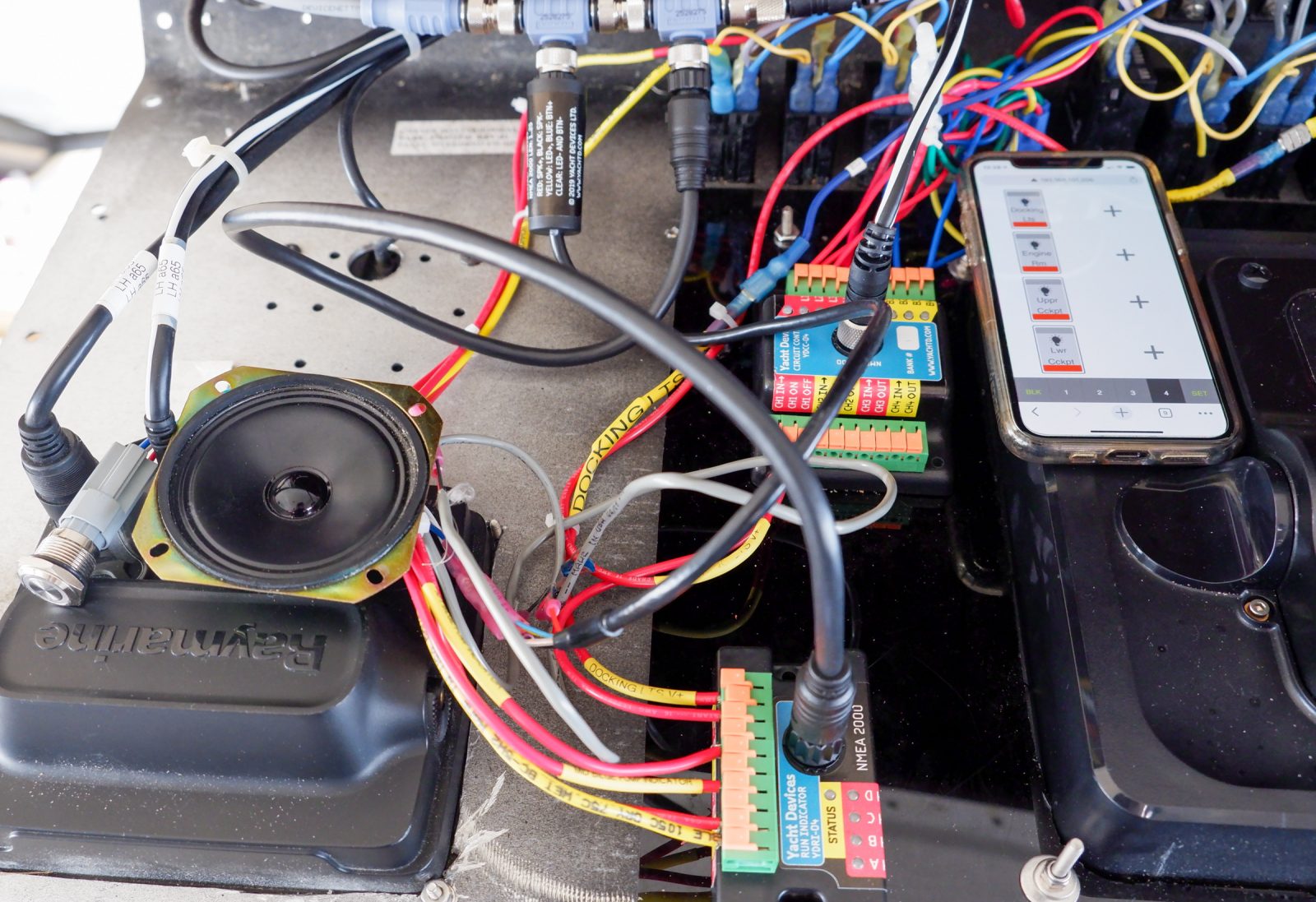
Yacht Devices Limited builds an impressive array of clever devices to solve specific needs aboard your vessel. Recently they’ve introduced a NMEA 2000 run indicator to monitor circuits aboard your boat and an alarm module that can notify you of problems or provide a man overboard button. These new products build on their impressive array of capabilities and make monitoring your boat easier and more powerful.
As a reminder, I also own the U.S. distributor of Yacht Devices’ products, Yacht Devices U.S. so I have both a greater level of familiarity with and a vested interest in their products. I became the distributor of their products after using them for some time and being impressed by the capabilities of their products and their clever solutions to challenges many boaters face.
Run Indicator

First up is the YDRI-01 Run Indicator; this device measures the voltage, and optionally current, of four circuits. Measuring voltage and current allows you to know if a circuit is on and operating normally. For devices like bilge or freshwater pumps you can be notified if they run for too long, are activated too frequently, or are drawing too much current. Similar to the Maretron Run Indicator Module (RIM-100), the YDRI uses digital switching PGNs (127501 and 127502) to share information with devices on your NMEA 2000 network. But the RIM-100 monitors six channels for voltage only, while the YDRI monitors four channels for both voltage and current.

To share its information with other devices on the network, the YDRI acts as a virtual NMEA 2000 digital switch. Events are communicated by toggling switching channels. By default, the unit comes set to digital switch bank 1 and uses channels one through four to indicate there’s current flowing through the run indicators four monitored circuits, identified as A, B, C, and D. Switching channels five through eight are used to indicate voltage present on circuits A through D. So, in the example above you can see that channels four and eight are on. This is because there’s a load through channel D that’s consuming current (turning channel #4 on) with voltage present (turning channel #8 on). In this case that load is the halogen docking lights on the stern of Have Another Day. In addition to the first 8 channels with their pre-configured roles you can use the remaining 20 channels as status indicators with the YDRI’s rules capabilities; which we will explore more below.

Configuration of both the run indicator and alarm button is performed using Yacht Devices’ Can Log Viewer software to update a NMEA 2000 standard parameter on each device called Installation Description 2. I’ve prepared a tutorial on the configuration process over at the Yacht Devices U.S. website.
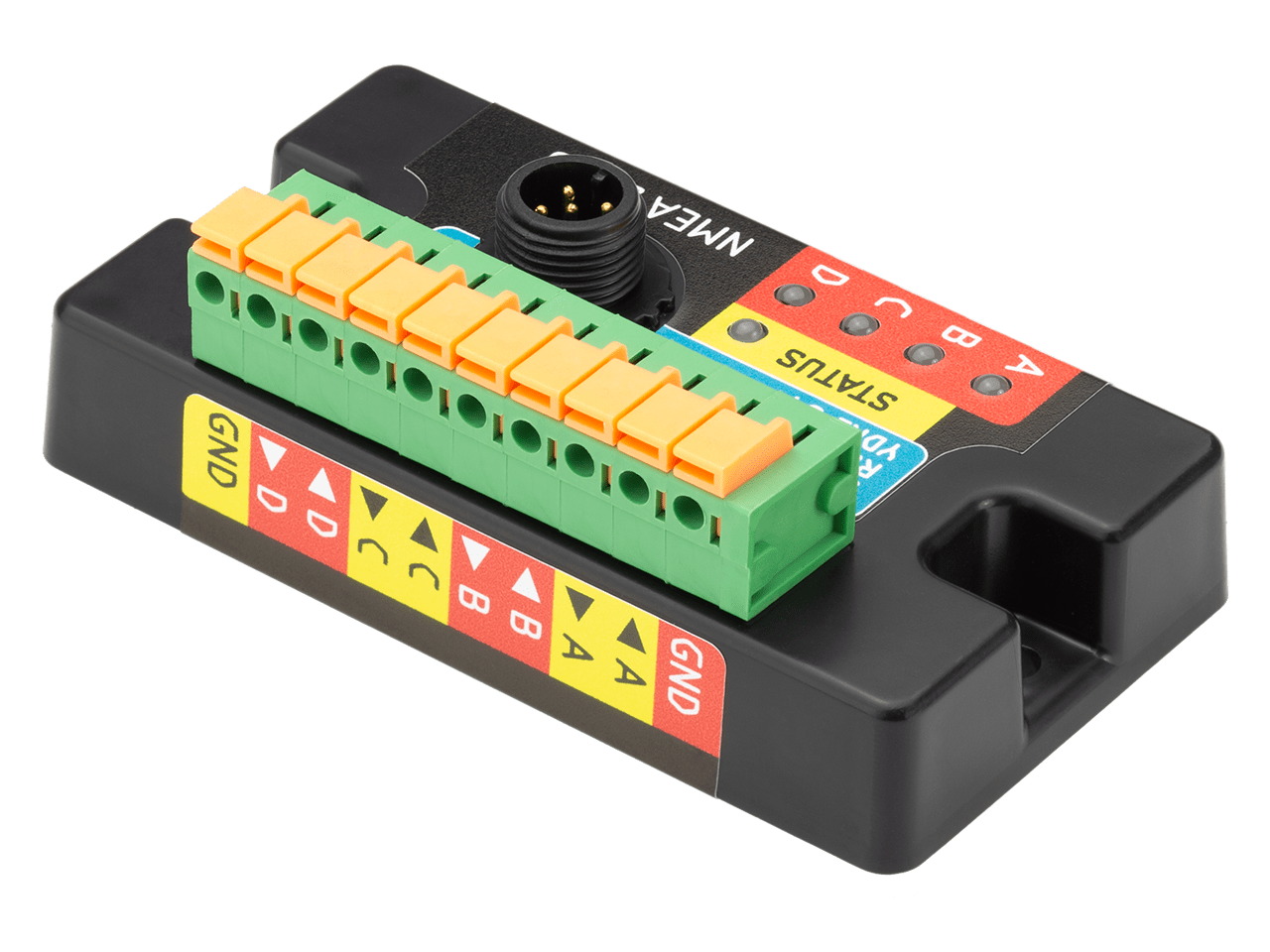
The LEDs on top of the run indicator indicate the status of switching channels 1-4 within the unit. By default these channels are turned on where there’s more than .2 amps of current consumption on a channel and off at less .2amps. But, you can use the device’s rules to change this behavior.
On Have Another Day I’m using a run indicator to monitor the status of my three primary bilge pumps and the docking lights. Monitoring current with the YDRI requires the circuit run through the run indicator, meaning the positive supply comes into the first terminal and the connection to the load goes out the second. Because my run indicator is located at the lower helm and the bilge pumps are much lower in the boat it’s not practical to run these circuits through the module. But, I do have indicator lights at both helms to show if a bilge pump is on. These indicators use 12 volts so I’ve run the positive from each of these lights to a channel on the run indicator. As a result I don’t get current information on the bilge pumps but I do know when they’re running.
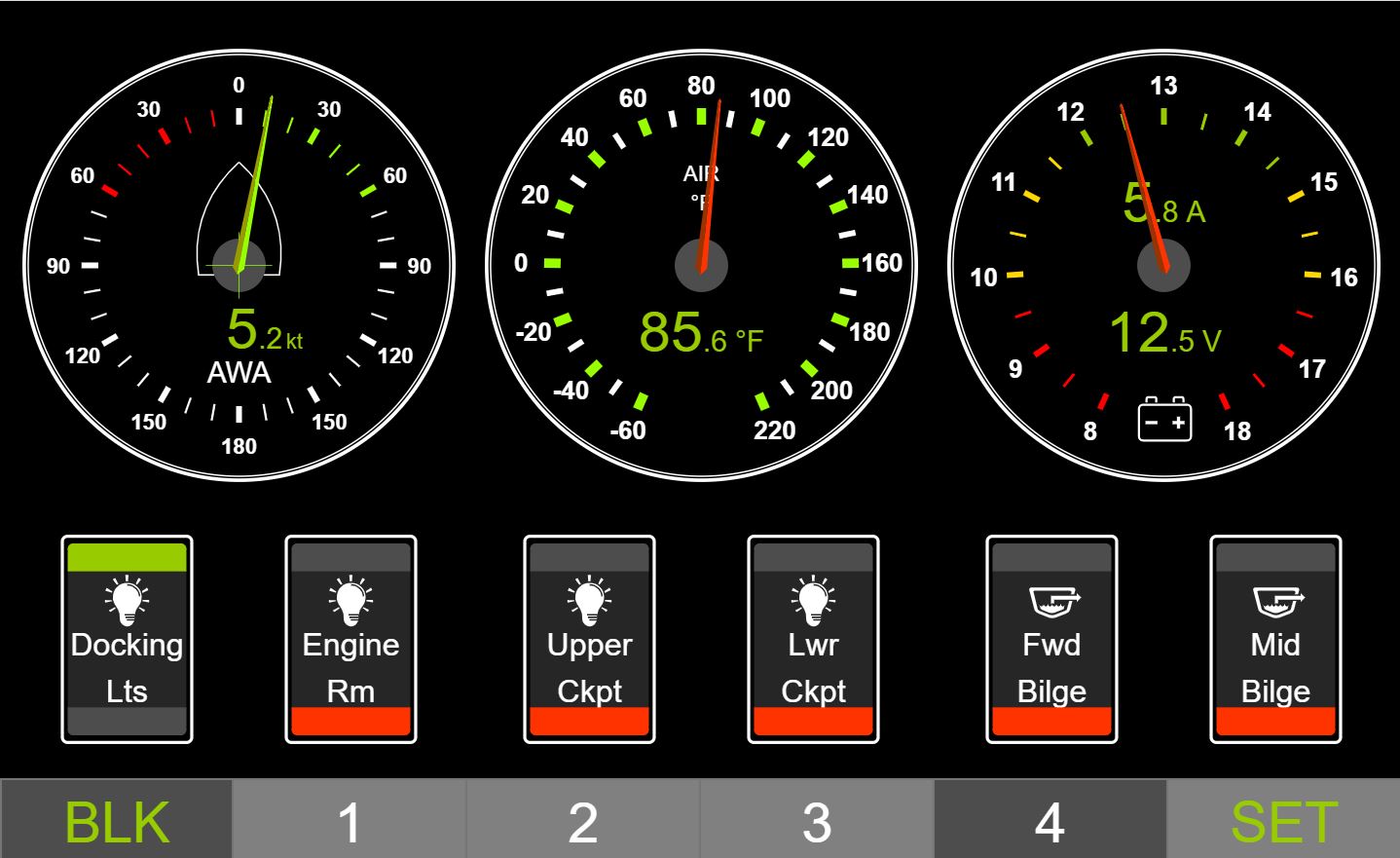
Reporting current isn’t limited to just on or off binary events. The top right of the Web Gauges screenshot shows current and voltage for channel D (web gauges are running on my YDWG-04 WiFi gateway). But you might have noticed the battery icon on the gauge and wondered what that’s about. Yacht Devices has used the NMEA 2000 PGN 127508 for battery status in order to transmit voltage and current information to allow easy display on equipment that already supports displaying battery information. They are also transmitting this information via PGN 127506 which is a more generalized data packet specified for DC device detailed status. PGN 127506 allows setting the type of the monitored device as battery, alternator, converter, solar, or wind generator. As these PGNs are adopted by other devices it’s likely to serve end users better to use the proper PGN but for now using the battery PGN allows displaying the information on more devices.
It also seems to me that neither of the options currently implemented is a perfect solution for monitoring individual devices. But, Maretron is able to report per channel amperage on their CLMD-12. I’d assumed they were doing this on standard PGNs but my review of all the digital switching PGNs doesn’t show any that support current reporting, just binary (on/off) reports. Thus, I’m now guessing they may be reporting this using 65300, a Maretron proprietary message. So, the standards might need to be expanded further to report this kind of data more elegantly.
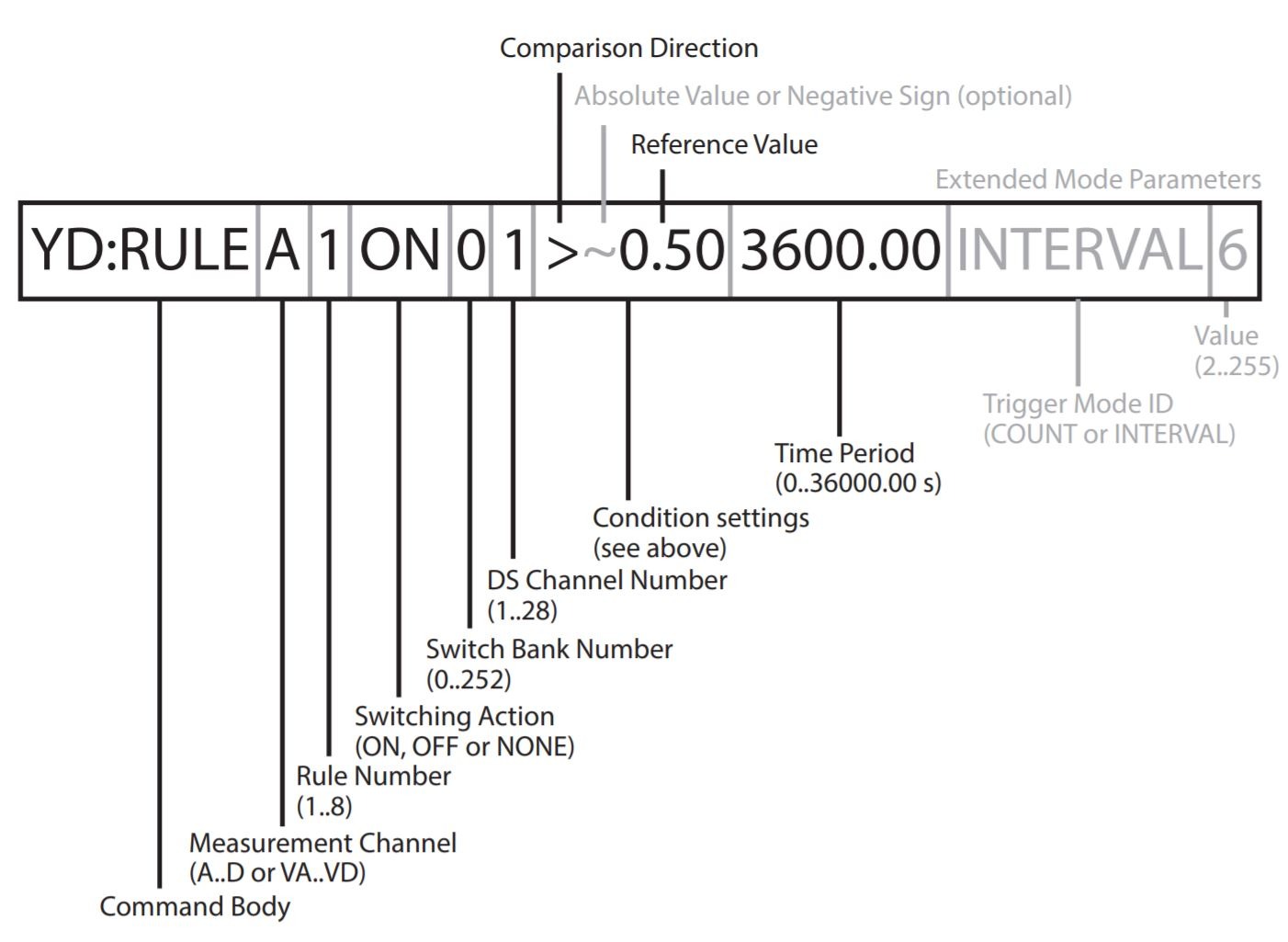
The real power of the YDRI comes when you start exploring the device’s rules. Rules can be used to turn on or off digital circuits based on voltage, current, time and counts of events. So, you can write a rule that controls a digital switching circuit if a bilge pump runs more than 5 times in an hour, or if it runs for longer than two minutes. The circuit that’s controlled could be one of the virtual circuits we’ve been discussing so far, but it could also be to a circuit controller that’s managing power to your freshwater pump. So now instead of running the pump indefinitely, you can shut it down once it’s run too long. This can help avoid emptying your freshwater tank but probably isn’t going to be helpful for a bilge pump that’s run too long. For that, you probably want some sort of signaling.
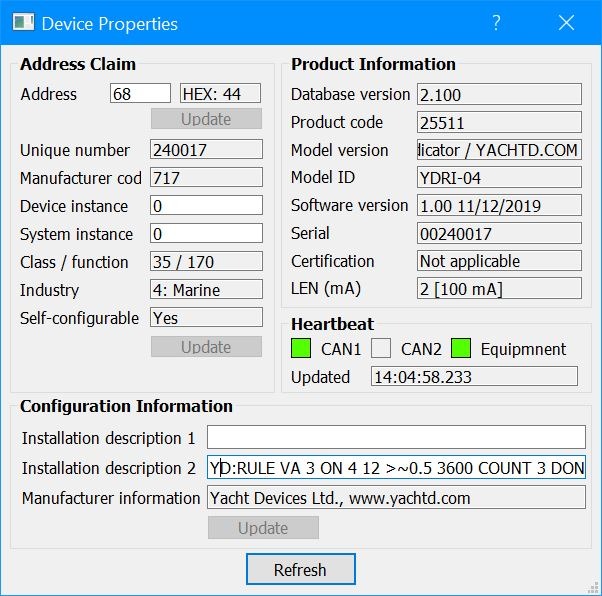
There are lots of ways these rules can be used, but in my testing I did come across one limitation. I’d like to be able to define a rule to alert me if a pump runs for more than X minutes over Y period of time. For example, if a bilge pump runs for a total of 5 minutes over a 60 minute time period, I’d like to hear about that. Even if it was over multiple runs in that time period.
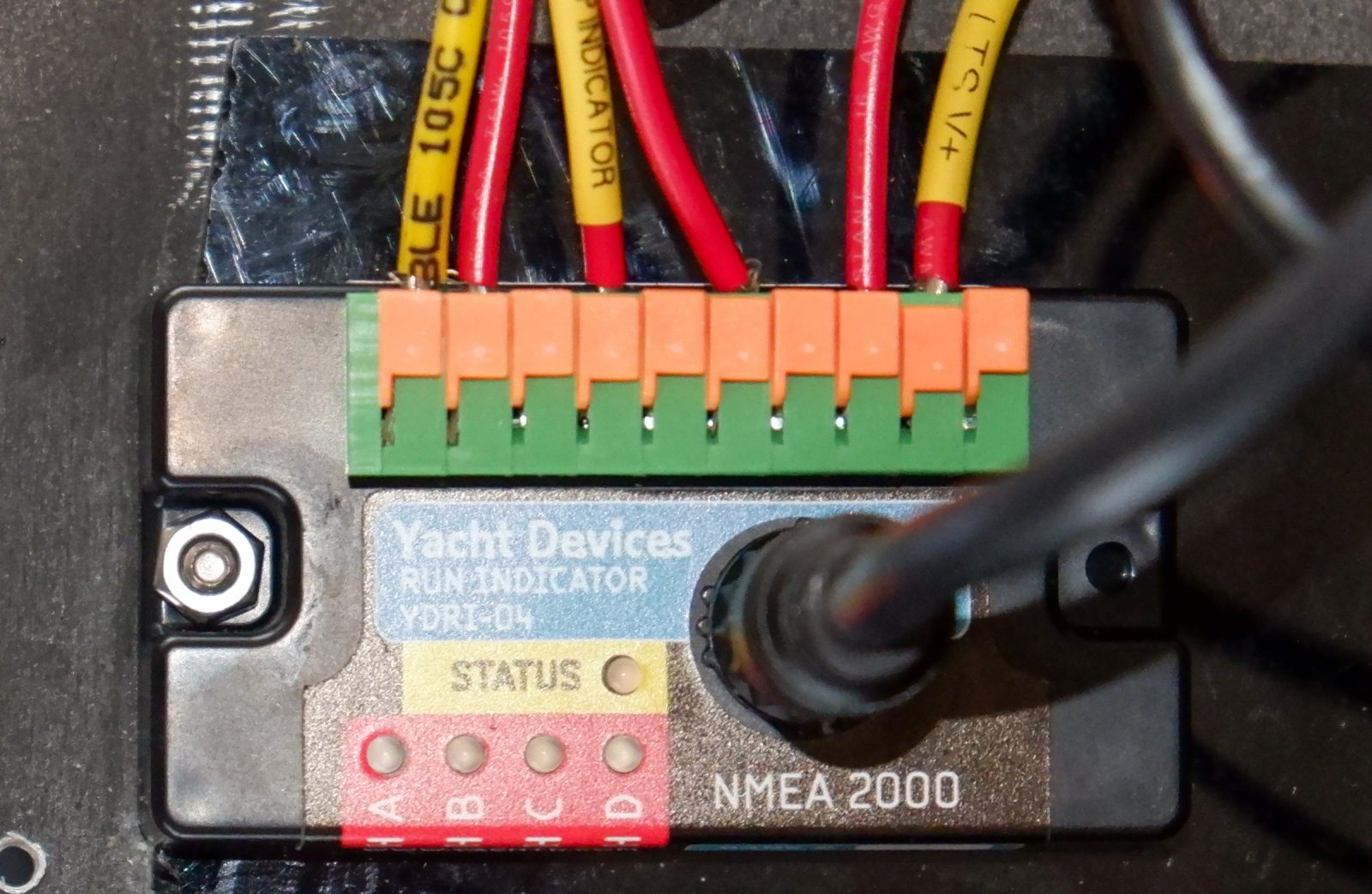
I’ve had troubles with wires pulling out of the push button cable clamps Yacht Devices uses and after a few failed experiments found they hold best if the wire is stripped to over half-an-inch and inserted fully into the clamp. I think I’d prefer screw terminals but with the longer conductor I’ve had good results.
Alarm Button

Remember I mentioned that you might want a way to sound a signal if a bilge pump runs too long? It turns out Yacht Devices also has a product well suited to the task. It’s called the Alarm Button or YDAB-01 and, in one of it’s modes, it notifies you that an alarm has been raised both by flashing LED — the LED is usually the ring of the button provided with YDAB but could be any LED you choose — and a connected speaker that can play any of 28 different sounds. I think the name alarm button doesn’t do justice to all the things this flexible little module can do.
The YDAB can be set in one of three modes, man overboard, digital switching, and engine alarm. The YDAB-01 has a NMEA 2000 load equivalent number (LEN) of 20 and that might affect where you install it. LENs are calculated based on the maximum current a device may draw with each LEN equaling 50 mA. Because the alarm button is powering a 10 watt speaker it has the potential to draw quite a bit of current. For this reason Yacht Devices recommends locating it close to the power source for the NMEA 2000 network or using a power isolator and second power drop very near the device. In my testing I’ve taken neither of these steps and haven’t had troubles, though I also have the volume set to 15 percent which should reduce the load.
Man overboard button mode
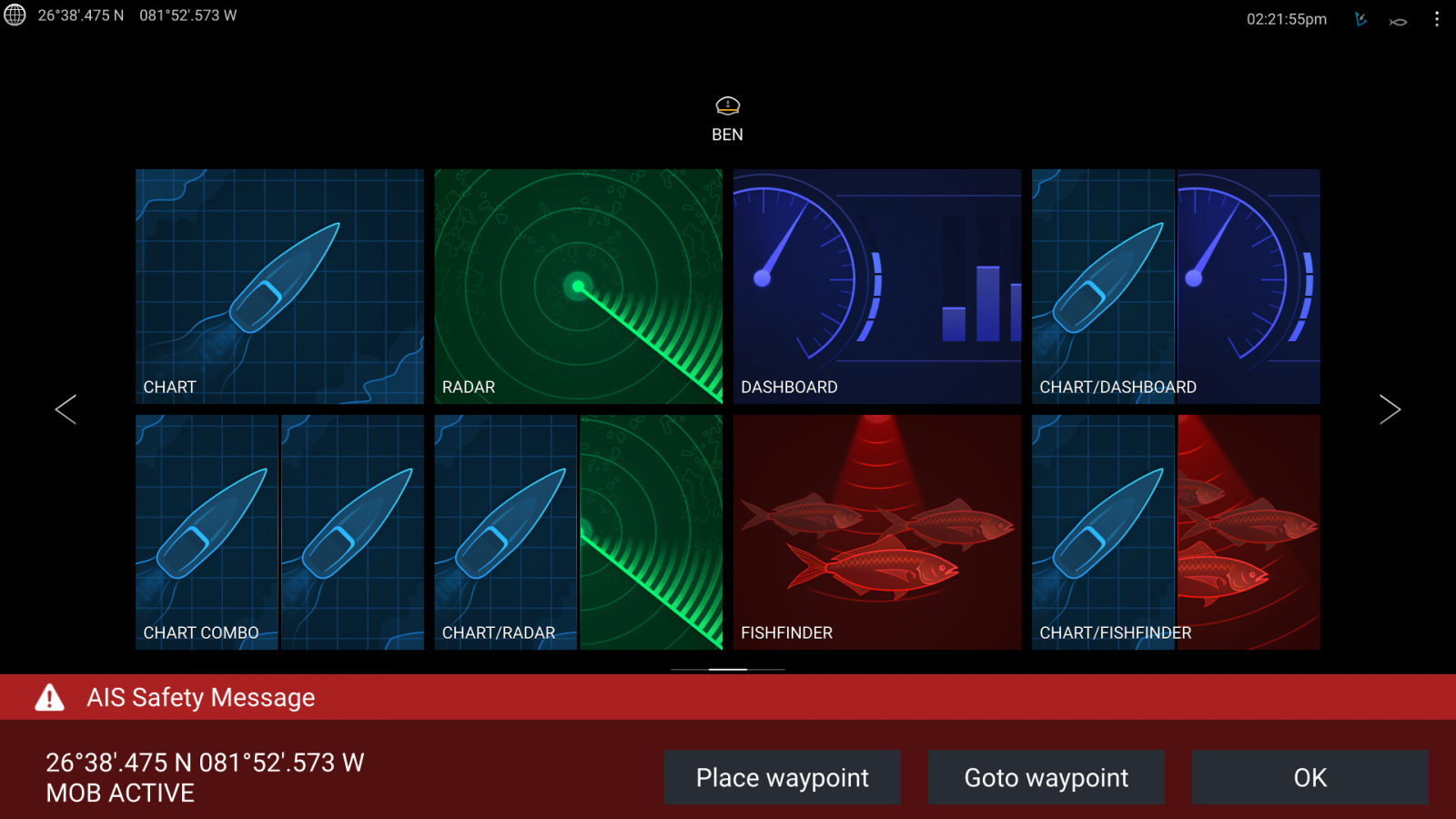
Man overboard mode sets the alarm button so that pressing and holding the connected button for two seconds triggers a man overboard event. This causes an audible siren from a connected speaker — and it’s loud — and sends an MOB signal on the NMEA 2000 network using PGNS 129038 and 129802. During my testing I received the MOB alert on MFDs from Garmin, Raymarine, and Simrad as well as on my Raymarine gauge displays. A second press of the button for two seconds will cancel the alarm.
Digital switching mode
When set to digital switching mode, the alarm button acts as a virtual digital switching device with 28 channels. Turning on each of these 28 channels will cause the unit to play one of 28 sounds and flash unique patterns on the connected LED. Sending the on command to channel 1 causes the device to play the sound and blink the led for channel 1 all the way through channel 28. When an alarm is triggered, pressing the button will silence the alarm. The default sounds for channels 25 through 28 can be replaced with user recorded sounds using Yacht Devices’ CAN Log Viewer software and either a Yacht Devices WiFi Gateway, Ethernet Gateway, NMEA 2000 Router, or USB Gateway. Plus, because this mode is using standard NMEA 2000 switching PGNs these features will work with other brands of NMEA 2000 compliant equipment, as I’ll show a little later.
Engine alarm mode
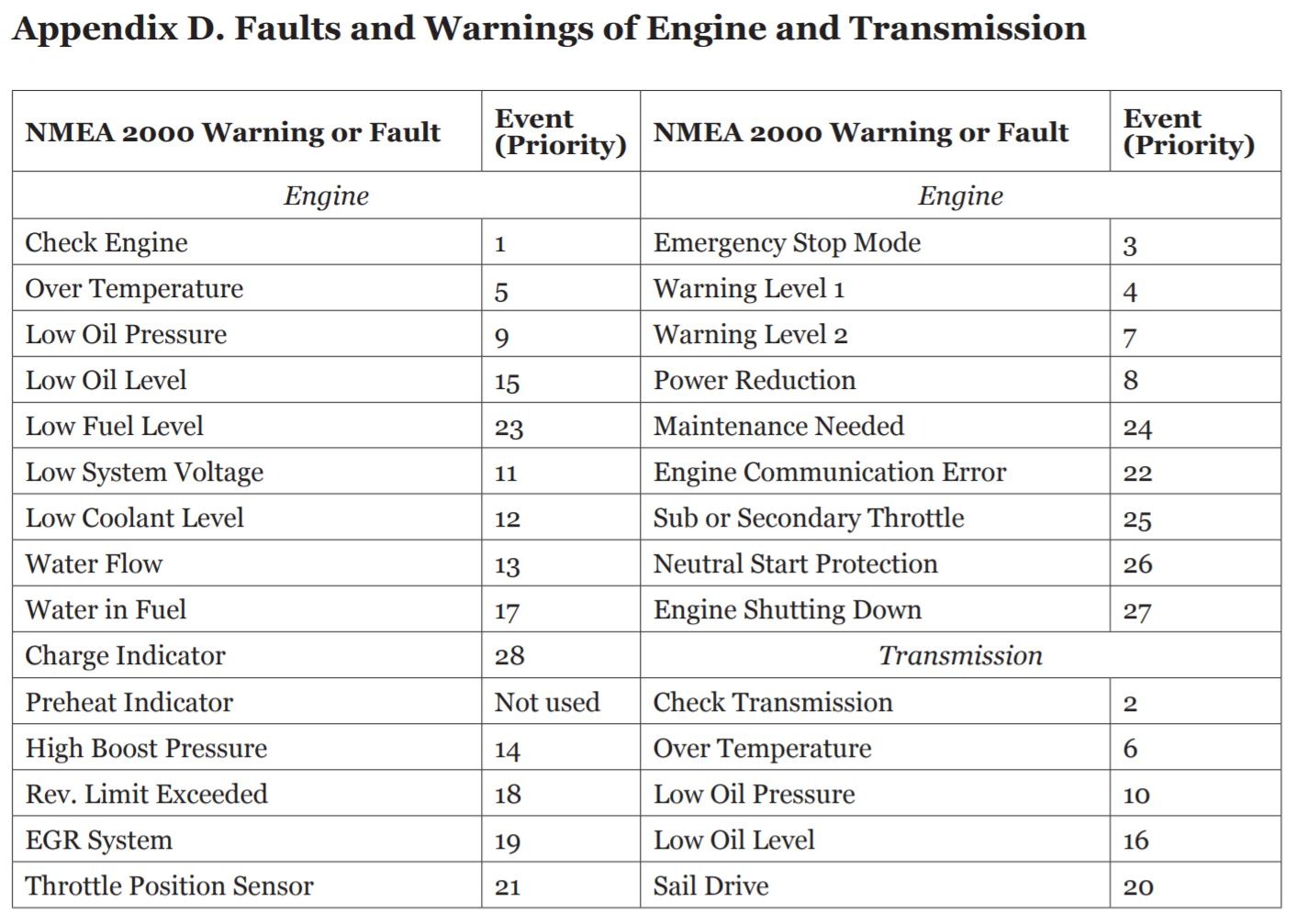
In engine alarm mode the alarm button is used to audibly and visually alert the operator that the engines have raised an alarm. The alarm button will work with any engine that is outputting data to the NMEA 2000 network. That data might come from a newer engine with native NMEA 2000 capabilities or any engine attached to a NMEA 2000 gateway or converter. A single alarm button can sound alerts for any engine on the boat or you can use one alarm button per engine, so that you can tell which engine has raised the alarm. Additionally user configured alerts can be set for engine RPMs, coolant temperature and boost pressure. For example would be to raise an alarm if the RPMs exceed 3,000 for at least 30 seconds. If multiple alarms are raised pressing the button to silence the first alarm will cause the second to sound.
Putting it all together
The video above shows several products working together to control the docking lights on Have Another Day. These are bright halogen lights on the stern of the boat that draw about 6 amps when they’re on. You wouldn’t really want to leave them on indefinitely so it could be helpful to have a reminder that they’ve been left on. The lights are controlled by a Yacht Devices YDCC, the device just to the left of my phone in the video. I’m using the web gauges served by a YDWG-02 to control the circuit. I’ve configured two rules in the YDRI-01 for when channel D is showing current running through it:
YD:RULE D 3 ON 4 25 >~1.0 12.00
YD:RULE D 4 OFF 4 25 <~1.0 4.00
The first rule is defined on channel D and is numbered as rule number 3 for the channel (there’s a limit of 8 rules per channel). The rule controls digital switching bank 4 channel 25 and fires when the absolute value, as indicated by the ~, of the current is greater than 1.0 amps for 12 seconds. The second rule is rule 3 for channel D and says to turn off bank 4, channel 25 when the current is below 1.0 amps for 4 seconds. At the same time my voice can be heard announcing the docking lights are on the LED ring on the switch begins flashing a distinct pattern as well.
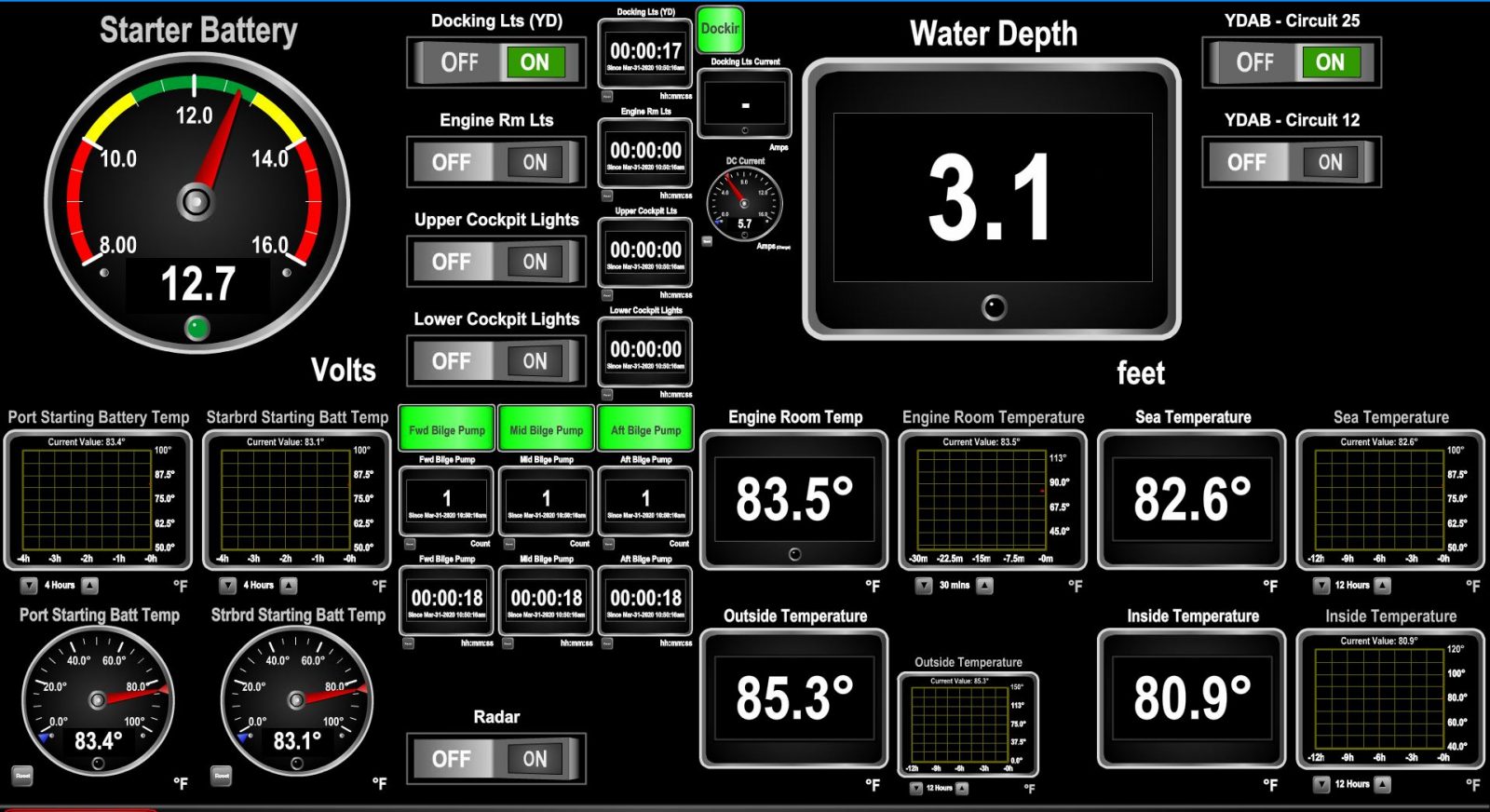
Because all these products communicate using standard NMEA 2000 PGNs I have the option of using other products to display the boat’s status. The screenshot above shows Maretron N2KView showing all three bilge pumps are running. The YDRI is sensing voltage from the indicator lights at the lower helm and hence turning on virtual switch channels 5, 6, and 7 to indicate the fwd, mid, and aft bilge pumps are running. Fortunately that’s just because I flipped them on with manual switches. I can also see that the docking lights are on, and, because their positive supply and load is run through the YDRI, we see that they’re drawing 5.7 amps. Lastly, they’ve been on for more than 12 seconds so the rule I configured in the run indicator has turned on circuit 25 on the alarm button, which causes it to play my recording and blink the LED, as you can see in the top right where I have a switch defined so that I can monitor the status of that virtual circuit.
About a month ago one of the 8D batteries that start my engines failed. I discovered the failure when I smelled the distinct odor of batteries off-gassing through an engine room vent. As I got between the engines I could feel the heat coming off the starboard start batteries and knew I’d found my problem. But, I only found the problem after it became bad enough to be detectable from outside the boat by smell.
So, I wanted more monitoring on the batteries and installed YDTC-13 temperature sensors above each battery bank. Now I have the ability to see the temperature of the bank, shown on the N2KView screen above, but I didn’t have any way to notify me of a problem. At the end of 2018 new firmware was released for all of Yacht Devices’ sensor products to give them the ability to control a digital switching circuit based on their measured values. This means that I was able to define the rule you see above in the installation description 2 box.
SW1 ON >35.00 10 4 13, OFF <35.00 10 4 13 DONE
This rule is numbered as SW1 (switching rule 1) and says if the temperature is greater than 35 degrees Celsius (95 Fahrenheit) for 10 seconds turn on switch bank 4 (the virtual switch bank for the alarm button) channel 13 (alarm 13). The rest of the rule says to turn off the channel if the value drops below 35 degrees Celsius for 10 seconds. Just like that I have the alarming I wanted with a minimum of dependencies. The only two things that have to be on are the temperature sensor and the alarm button.
Final thoughts
What I’ve just described is an impressive, and possibly dizzying, series of capabilities. By using NMEA 2000 standard switching commands Yacht Devices has enabled a great deal of flexibility. Plus, by using NMEA 2000 standard PGNs they should enjoy good compatibility with other manufacturers also using standard PGNs. But, because Yacht Devices has basically given you a tool box full of tools you’re going to need to do some thinking and planning on how to implement all this goodness. Together these products give you a lot of capabilities but it’s up to you as the user to configure them to work together. I’m hopeful that over the interface for configuring these products might get more polished, but in the meantime, if you can deal with the bare bones user interface you get rich functionality at very affordable price points.





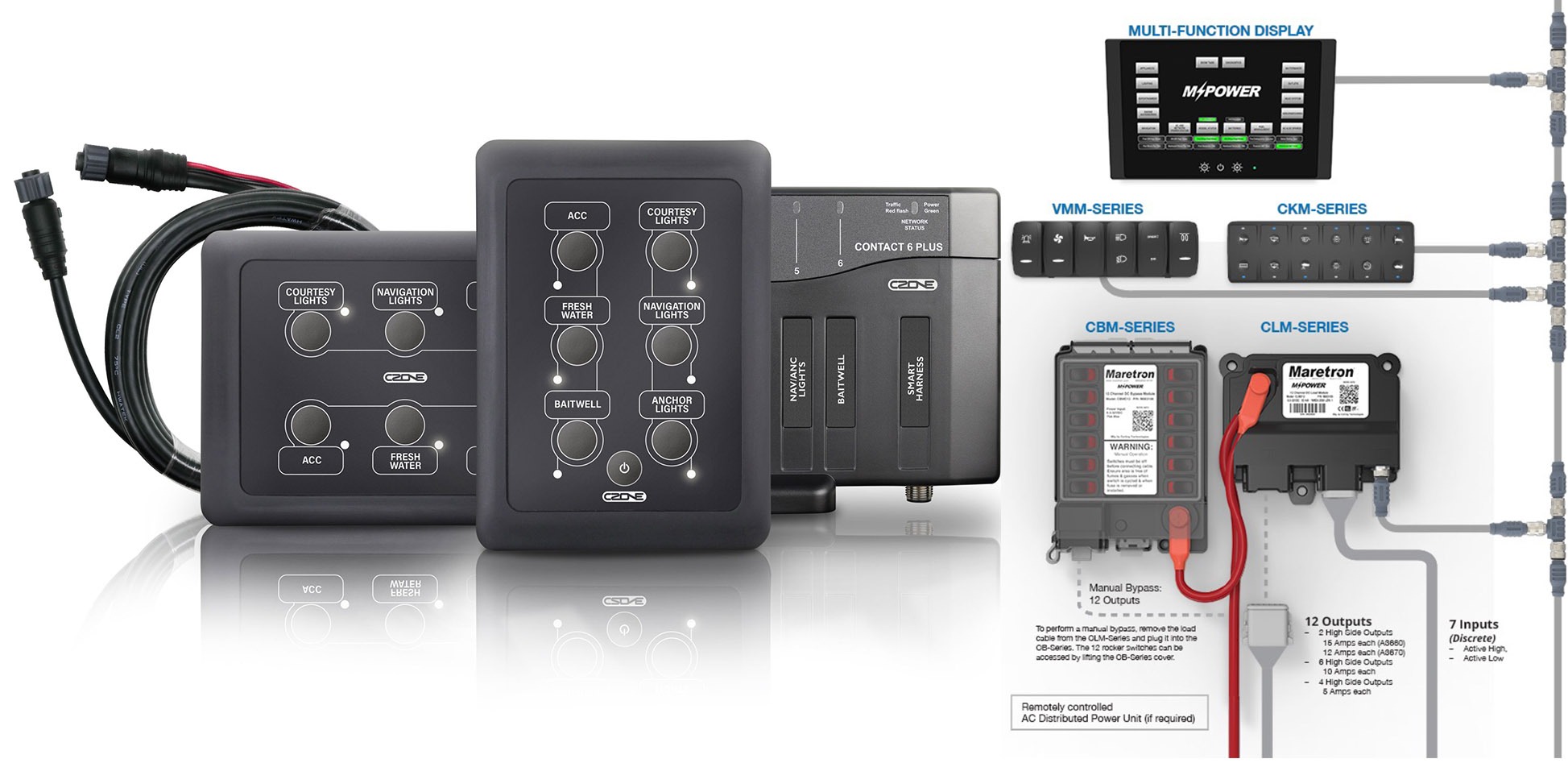










Ben – this post must have taken you WEEKS to put together, but I suppose most of us have extra time on our hands these days… I must confess my eyes started to glaze over about half way through. I think perhaps this unit should be packaged with an 8 hour configuration trip by a NMEA2000 Master installer!
For those of us not quite up to that level – Could you just confirm if I can monitor voltage only from 4 discrete battery banks, with minimal configuration, and display them on an appropriate NMEA 2000 device, like a Maretron DSM410?
I’ve been looking for an economical way to do this, and so far haven’t found it – Thanks,
Grant – As you note, this wasn’t a short or lightweight post. It’s one of a few topics I’m working on right now where there’s so much that can be done that it’s a challenge to describe all the options. I’m sorry to hear I lost you partway through, and can tell you I was concerned that might happen.
I can confirm you can use the YDRI as a means of monitoring voltage on four separate battery banks. Each bank will show up as a NMEA 2000 battery (appropriately enough in this case) and show voltage but 0 amps unless you run the bank through the YDRI, which is unlikely to be possible because of amperage limits.
-Ben S.
OK Ben, thanks for the quick response. To be clear, I do appreciate your detailed reporting, on this and other topics – it’s just way more capability than I can reasonably absorb at present. I’m looking forward to setting one up as a battery monitor, however! Cheers,
Hey Ben, I want to doublecheck the following and it may be good for reader clarification. To monitor four different battery banks (or simply the voltage/amperage at a device) doesn’t the following have to be true:
1. Each battery PGN has to have a different Instance number?
2. The display has to be able to distinguish battery PGNs with different Instance numbers?
I trust that the YDR1 monitoring circuits can be set up with specific Instance numbers and I know that Maretron displays can be set up to read a PGN with a specific number, but that ability seems to vary with other brand displays.
Please correct or confirm.
Ben,
Your understanding is correct. Each battery will show up as a separate instance in NMEA 2000. By default the device assigns instance 0 to circuit A, 1 to B, 2 to C, and 3 to D but you can change these settings and assign instances between 0 and 252 to the circuits.
I think you’re also right that the way the data is displayed will vary among manufacturers. I’m going to do some experimenting and I’ll report back about some of the common displays.
-Ben S.
Here’s a bit of good news I wasn’t expecting. I just tried this on an Raymarine a67 I have on the boat. In the data app there’s a battery category that supports battery voltage, amps and temperature and it supports batteries 1-4. My doing lights are on channel D (instance 3) so I selected amps for battery 4 and was able to watch the gauge correctly display amperage for the lights. I’ll do some more experimenting but I’m pleasantly surprised to find that an older display running Light House II successfully displays the data.
-Ben S.
Thanks, and good news on the Ray a67. But let’s also discuss Labeling data like this. In my experience, Maretron is great about this. If, say, Grant was using their battery monitoring, he could custom name them in the DCM100 config and that label would be available on any Maretron display. Or if (saved money and) used the YDR1, he could write a custom data label on any Maretron display.
CZone can push Labels to supported MFDs, but I can’t think of other cases where they work between brands and many displays don’t include them at all, although I think that Labeling is part of the N2K standard. I whined about this situation years ago, but it didn’t do much good 😉
https://panbo.com/maretron-dcr100-partial-install-lights-on-labels-up/
I ordered a YDNU-02 on March 16 from Yacht Devices. No idea where it is. I’d like to order some more, but how long will it take to get these.?
David, If you haven’t received an item ordered two weeks ago I suspect you placed the order with Yacht Devices Limited out of eastern Europe, not from Yacht Devices U.S., the U.S. reseller. Packages from Yacht Devices Limited typically take two to three weeks to make it to the U.S., but things seem to be running slower currently.
-Ben S.
At the the time I ordered, I didn’t know there was a USA distributor. Thanks for the heads up.
David
Ben, This is a great write up!
I think you are likely right that the CLMD-12 is using a proprietary PGN for current info. They use proprietary PGN 65284 for current on the DCR100. That is rather interesting if they chose a different proprietary PGN for the CLMD-12.
It seems like YachtD came up with a pretty interesting solution…
Can the alarm module “annunciate” an alert from a Maretron DSM 410 (similar to their ALM100 module)?
I don’t think it could in direct response to the DSM 410. From the Maretron manual it appears they’re using a proprietary PGN for the alarm messaging while hoping NMEA will approve an official alarming PGN. Yacht Devices tackled the problem of no approved alarming PGN by using switching PGNs instead of a proprietary alarming PGN. Neither of these solutions is ideal and both come with trade-offs, but without an approved PGN it’s the choice manufacturers are left to make.
If the underlying device that the DSM 410 is using for its threshold can send a switching message then you could use the YDAB but if not, you may have to stay within Maretron’s options.
-Ben S.
Great write up. Thx!
i noted recently that a purchase i made from yachtbdevices was shipped from russia direct to me,
i also note thatbwith some further investigation thatbtheir business is registered/headquartered in russia.
thats a shame as i liked their products.
in light of recent events. this will be my lastbpuechase from this company and as a sign of protest i destroyed the device before installing it…
and im ensuring that all my community of marine contacts and boaters are aware of this – dor them to make their own informed decisions ..
Hi Greg,
As I mentioned in the original article, in addition to my work with Panbo I own Yacht Devices U.S., a U.S. based reseller of Yacht Devices Limited’s products. Yacht Devices Limited is based in Kaliningrad, a part of the Russian Federation. Kaliningrad is on the Baltic Sea between Poland and Lithuania. All of Yacht Devices’ parts are made in Lithuania, though as you note, the headquarters are in Kaliningrad.
I am as disgusted with the acts of war by Russia in Ukraine and we all must find our own ways to express that disgust and outrage.
-Ben S.
Just ordered one from Yacht Devices US, I have a couple of other Yacht Devices products and have been pleased. I’m installing a Mermaid AC in my in my boat and am trying to think of a way to have the YDRI-04 be able to show when the AC (or reverse cycle heat) is running. I realize the YDRI-04 can only do DC, any thoughts?